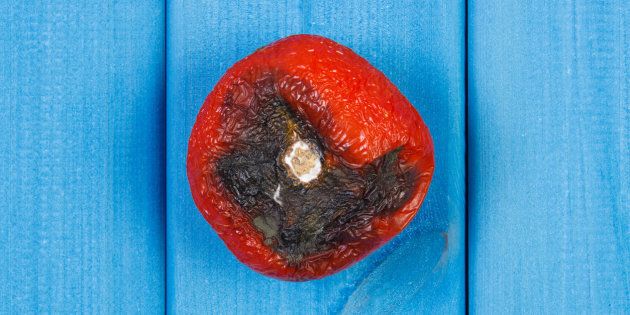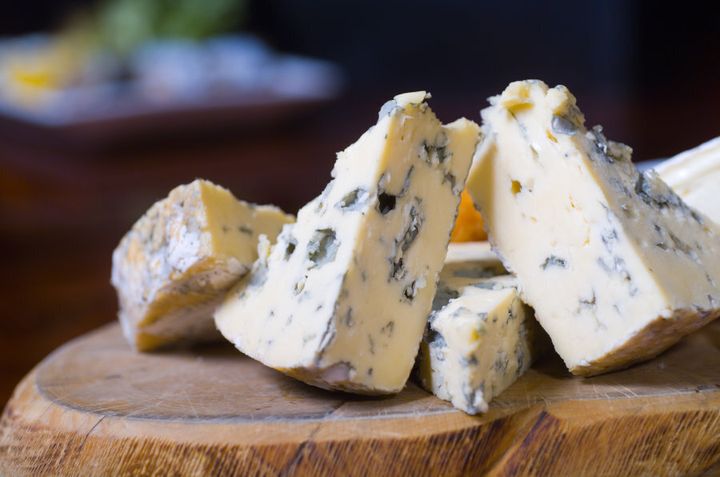
Here's the scenario. You're really hungry, you're making a sandwich and you're particularly pleased because you know there's some cheddar in the fridge that is going to make this sanger sing. Only when you finally locate said cheese, there's some blueish mould tingeing just one of its corners.
So what do you do? Do you cut off the offending mouldy bit and proceed as normal? Or do you bite the bullet and throw the whole thing into the bin?

"The only foods you should eat that are mouldy are the ones you know should be mouldy," Rachelle Williams, Chair of the Food Safety Information Council told The Huffington Post Australia.
"So to use blue vein cheese as an example, that's meant to be mouldy, so it's okay to eat. Anything else, you should avoid."
If you're thinking, 'but I didn't actually eat the mouldy part per se...' it turns out it's not actually quite that simple, and when it comes to mould, what you see is not always what you get.
"The easiest way of thinking about mould is to think of a tree," Williams said. "Most of the tree is not always above the ground -- it's below.
"What you see is the part at the top, when you think about the roots, they go way down into the ground and can actually be bigger than what's visible above.
"The same premise is true of mould. While you chop off the bit of mould you can see, if you think about the 'roots' (or filaments) they are going down into the food.
"Look, the simplest thing to say is 'don't eat it'."

In terms of exactly why foods like blue cheese are okay but your mouldy cheddar isn't, it all comes down to the type of mould that grows on them and whether or not they're likely to make you sick. In short: deliberately mouldy foods are fine. Others are not.
"There are good moulds and bad moulds, good bacteria and bad bacteria," Williams said. "The moulds that go into blue vein cheese and camembert and brie, they are actually deliberately added into the mix... it's part of the effect."
Five to 60 degrees is what is called the temperature danger zone. This is where bacteria grows best.
According to Williams, if (unintentionally) mouldy food is common in your house, you might want to think about your approach to waste and food storage.
"Basically it suggests you are not turning over your food often enough," she said. "It's sitting in fridge too long."
Williams suggests if that is a habit you're accustomed to, then you may be at a higher risk of getting food poisoning.
"The thing is, only some foods will go mouldy. Not all food will," she pointed out. "And the thing to be aware of is the bacteria that cause food poisoning are not actually moulds. Mould is the green, blue or grey things growing on foods. Bacteria you can't actually see -- it's invisible to the naked eye."
Smelling your food is not a good indicator of whether it's off or not.
"The other thing worth mentioning is you can't necessarily smell a food to know if it's off or not. The smell doesn't mean anything," Williams continued.
"Yes, some bacteria do produce smells, and that is very obvious when it happens. But just because a food doesn't smell, it doesn't mean it's safe to eat. Smelling your food is not a good indicator of whether it's off or not."
In terms of how to store mould-prone foods, the general rule is to keep them at a temperature below five degrees Celsius. But as anyone who has found that slightly mouldy block of cheddar will tell you, refrigerating your food won't stop mould altogether.
"Five to 60 degrees is what is called the temperature danger zone," Williams said. "This is where bacteria grows best.
"When you are below five degrees, bacteria slows down."

If you're wondering 'what do you mean 'slow down?' then consider this:
"If you think of food poisoning bacteria as just one cell, what happens when they reproduce is they split," Williams said.
"One type of bacteria will [reproduce] every 20 minutes at room temperature. Then there's another one that does it every seven minutes. Basically it depends on how quickly they double, and the quicker they double, the more bacteria will be present. Generally, at room temperature, the bacteria are doubling away happily, whereas at a temperature above 60 degrees they start to die because they don't like heat, and below five degrees the reproduction will slow.
"That's where we get the 'use by' and 'best before' dates from. It's a date set by manufacturers because at that point, the amount of bacteria [in the food] exceeds what the law allows."
So, to break it down: basically your food will have bacteria in it no matter what you do, and that bacteria reproduces or grows more plentiful over time. Keeping your food below five degrees will help slow the process, but there will still be a point in time where there's too much bacteria for the food to be considered legally safe to eat. It might look mouldy or it might not, but either way, it needs to go in the bin if you want to avoid a bout of food poisoning.

Oh, and freezing food doesn't stop bacteria, either. It just puts it to sleep.
"When you freeze the food, that bacteria is still there," Williams said. "Single cell organisms are much much more simple than we are, and if you put them in the freezer, the bacteria will just go to sleep or become dormant.
"Just like bacteria in the fridge slows down (the colder you get, the slower it goes), the freezer doesn't eradicate bacteria, it just slows it down to the point of hibernation. What's really important to keep in mind is, when thawing something out, to avoid putting it on the bench and thawing at room temperature. Always thaw your food in the fridge to minimise bacteria."
The main thing to remember, and the point Williams keeps on coming back to, is that eating mouldy foods isn't okay, and in some circumstances, can actually make you sick.
"So if you think of mould on a hard cheese like a cheddar, a lot of people get the cheese and say, 'oh it's only mould, we'll just cut this bit off', but if you think about all those little bits [that you can't see] growing into the rest of the cheese, it's not a great idea," Williams said.
"It sounds like a hard and sterile thing to say, but if it has mould on it, throw it out. Or give it to your dog or the chickens. They won't care. For us, these moulds can actually make us sick."
Those wanting to find out more about food safety can do so here.
This story was originally published on 24/08/2016